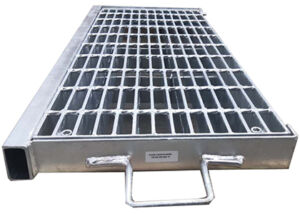Trench covers for parks and gardens play a crucial role in maintaining the aesthetic and functional integrity of outdoor spaces. These covers are designed to conceal utility trenches, ensuring safety and visual appeal. By integrating trench covers into park and garden designs, landscape architects can create a seamless environment that enhances the overall experience for visitors.
One of the primary benefits of using trench covers in parks and gardens is safety. Open trenches pose significant hazards, especially in areas frequented by children and pets. Trench covers provide a protective barrier, reducing the risk of accidents while allowing for easy access to underground utilities when necessary.
Aesthetic appeal is another significant advantage of trench covers for parks and gardens. These covers can be designed to blend in with the surrounding landscape, using materials and colors that complement the natural environment. This integration helps to maintain the beauty of the park or garden while ensuring that essential utility access remains unobtrusive.
Durability is a key consideration when selecting trench covers for outdoor applications. Parks and gardens are subject to various weather conditions and heavy foot traffic, making it essential to choose materials that can withstand these challenges. High-quality trench covers are made from robust materials like reinforced plastic or metal, ensuring long-lasting performance.
In addition to safety and aesthetics, trench covers can also enhance the functionality of parks and gardens. They can be designed to support various activities, such as walking or cycling, by providing a stable surface. This versatility makes them an excellent choice for multi-use areas where different types of activities occur.
When selecting trench covers for parks and gardens, it’s vital to consider the specific needs of the location. Factors such as the volume of foot traffic, the types of activities taking place, and the overall design of the space should all influence the choice of trench cover. Custom solutions may be necessary to ensure optimal performance and appearance.

Installation of trench covers should be carried out by professionals to ensure that they are securely fitted and level with the surrounding ground. Proper installation is crucial for maintaining safety and functionality. Additionally, regular maintenance checks can help identify any wear or damage that may occur over time, allowing for timely repairs.
Another aspect to consider is the environmental impact of trench covers. Many modern covers are designed with sustainability in mind, using recycled materials or eco-friendly manufacturing processes. Choosing environmentally friendly options can enhance the park’s appeal to visitors who value sustainability and conservation efforts.
Incorporating trench covers into the design of parks and gardens can also support local wildlife. By creating safe, accessible spaces for both people and animals, these covers can contribute to biodiversity within urban environments. Thoughtful design can ensure that wildlife can navigate the area without encountering hazards from open trenches.
Community engagement is essential when planning for trench covers in public parks and gardens. Involving local residents in the design process can lead to solutions that meet the needs and preferences of the community. This collaboration can foster a sense of ownership and pride in the space, encouraging its use and preservation.
Accessibility is another critical factor in the design of trench covers. Ensuring that all visitors, including those with disabilities, can navigate the park or garden safely is vital. Trench covers should be designed to provide a smooth transition across different areas, facilitating easy movement for everyone.
The cost of trench covers can vary significantly based on materials, design, and installation requirements. While it may be tempting to opt for the cheapest options, investing in high-quality trench covers can save money in the long run by reducing maintenance needs and enhancing safety. Budgeting for these essential components is crucial in park and garden planning.
Trench covers can also be used creatively in parks and gardens to serve multiple purposes. For example, some covers can incorporate seating areas or planters, adding functionality and beauty to the space. By thinking outside the box, landscape designers can maximize the utility of trench covers while enhancing the visitor experience.
Education about the importance of trench covers in parks and gardens can help raise awareness among the public. Informational signage can explain the purpose of these covers and their benefits, promoting a greater understanding of park maintenance and safety. Educating visitors can foster respect for the space and its features.
Regular inspections and maintenance of trench covers are essential to ensure their longevity and effectiveness. Parks and gardens should have a routine maintenance schedule to check for damage or wear, addressing any issues promptly to prevent safety hazards. This proactive approach can enhance the overall quality of the park or garden.
The choice of trench cover design can also reflect the cultural and historical context of the area. Incorporating local materials or design elements can create a sense of place, connecting visitors to the community’s heritage. This thoughtful approach can enhance the identity of the park or garden, making it a unique destination.
As cities continue to grow and develop, the need for well-designed parks and gardens becomes increasingly important. Trench covers play a vital role in these spaces, ensuring that essential utilities are accessible while maintaining safety and aesthetic appeal. Investing in quality trench covers is a step towards creating vibrant, functional outdoor environments.
Local governments and organizations can collaborate to fund and implement tranĉea kovrilo projects in parks and gardens. By pooling resources and expertise, communities can enhance their public spaces, making them safer and more enjoyable for everyone. This collaboration can lead to innovative solutions that benefit all stakeholders involved.
In conclusion, trench covers for parks and gardens are essential components that contribute to safety, aesthetics, and functionality. By selecting the right materials, designs, and installation practices, communities can create inviting outdoor spaces that cater to the needs of all visitors. Investing in trench covers is an investment in the future of public parks and gardens, ensuring they remain safe and beautiful for generations to come.

